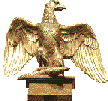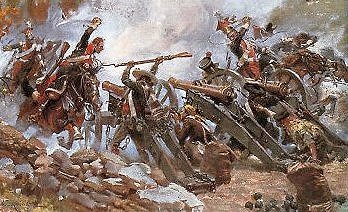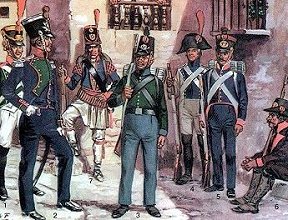
Battle of Somosierra
November 1808
The charge of "these gallant warriors ...
can hardly be paralleled in the annals of war...
The charge itself, viewed as a simple military operation,
was extravagantly rash ..."
- William F.P. Napier (ext.link)

"Pire's [French] cavalry advanced and then retreated. 'It's impossible !' - Pire exclaimed. The Emperor cracked his riding-whip. 'Impossible ? I don't know the meaning of the word !' "Poles, take the cannons !" Kozietulski led the Poles with the cry "Forward, you sons of dogs, the Emperor is looking at you !" The artillery and musket fire decimated the leading troop.
"Nearly the whole of the squadron was laid low ... I only saw one trumpeter left standing, motionless in the midst of the firing which was still going on. The poor child was weeping for his squadron..." The cannons were silent. Awed Emperor Napoleon saluted the Poles: "I proclaim you my bravest cavalry !"
Napoleon's march on Madrid.
In summer 1808 however approx. 18,000 French soldiers marched into captivity in what became known as the capitulation of Baylen. The French under General Dupont were defeated by the Spaniards. It was the greatest defeat the Napaoleonic empire had ever suffered.
Napoleon was furious.
The Emperor gathered his corps and entered Spain.
Gates writes: "The emperor, at the head of 45,000 men, resumed his march to Madrid on 22 November. Comforted by the success of the maneuvres in the north and east, he pushed on to the Somosierra Pass, which he found defended by some 9,000 troops, hastily gathered together by General San Juan. The Spanish corps was an extemporised formation, consisting of units of the 'Army of the Centre' left by Castanos in the capital, and a hotchpotch of odd battalions, volunteers and levies. Nevertheless, strongly entranched at the head of the pass, they constituted a formidable barrier to the French advance and the task dislodging them was obviously going to be a tedious affair." (Gates - "The Spanish Ulcer' p 104)
Napoleon's army marching on Madrid was faced with 21,000 Spanish troops. Of this force 9,000 men were dispatched west to guard the Guadarrama Pass. Approx. 3,000 occupied an advanced post at Sepulvida, and 9,000 men were on the heights of Somosierra. (Sources vary on the strength of the Spanish troops from 6,000 to 15,000).
The quality of Spanish troops varied from poor to good. The militia was generally of poor quality, but some regulars were fine troops. There were numerous examples of bravery of the
Spanish regulars. For example on 29 October "The First Regiment of Catalonia ... received the attack with the greatest coolness and kept up a very regular fire by platoons, maintaining their position against an enemy nearly 5 times their number ... The most veteran troops could not possibly have displayed more soldeirlike firmness or more sangfroid in action ..." (- W.Parker Carroll to Castlereagh, Nov 1808)
The Spanish troops at Somosierra were led by Don Benito San Juan.
Benito de San Juan served as a Lieutenant-Colonel of Hussars of Estremadura during the War of the Oranges. He was promoted to the rank of Colonel. Soon afterwards he was again promoted, this time to the rank of Brigadier. In 1805 promoted to the rank of mariscal (in fact a general's grade), he became the General Inspector of Infantry and Cavalry.
During the Peninsular War Benito de San Juan assumed the command over the major part of the Spanish forces defending Madrid. Knowing the weakness of his corps, much inferior to the French army, he prepared a plan of indirect defence of the Spanish capital by defending the Somosierra pass on the road leading towards it.
Adolph Thiers in L'Histoire du Consulat et de l'Empire, de Segur in Victoires et Conquetes and William Napier in History of the War in the Peninsula claimed that all guns were placed in one battery.
Other authors, for example Marian Kujawski, gives 16 guns in four batteries 4 guns each.
The Emperor thought that two infantry divisions should be enough to capture the pass and defeat the enemy. On November 29th one squadron of Guard Chasseurs-a-Cheval attacked the Spanish advance guard at Cereze de Abajo. The guardsmen however were unable to move further.
Seeing the cavalry alone unable to make progress, the Emperor sent in the advance guard
under GdB Lebrun. It consisted of the following troops:
At 7 am arrived three regiments of French infantry;
It was getting dark. A Pole standing by the fire lit his pipe in the Emperor's presence.
'You might at least thank His Majesty for the priviledge' his officer scolded.
"I'll thank him up there" replied the trooper pointing to the Somosierra Pass.
.
Map of battle of Somosierra 1808
Map of the battle of Somosierra on a Spanish website
>>
 1. Napoleon's march on Madrid.
1. Napoleon's march on Madrid.
- - Spanish troops at Somosierra. >
- - The batteries. >
- - French troops at Somosierra. >
- - Map. >
2. The charge.
- - The French and Spanish infantry exchanged musket fire. >
- - "Poles, take the cannons !" >
- - The first battery. >
- - The second battery. >
- - The third battery. >
- - The fourth battery was captured, lost and recaptured. >
3. On Madrid !
4. Myths and Legends.
- Napoleon

"The emperor, at the head of 45,000 men,
resumed his march to Madrid on 22 November."
Gates - "The Spanish Ulcer"
 Why had He invaded Spain ?
Why had He invaded Spain ?
There were several reasons; desires to extend the benefits of the French Revolution, dreams of conquests, and hatred of the Bourbons. Napoleon said to Roederer: "Spain ... must be French. ... I have dethroned the Bourbons for no other reason than it was in the interest of France to assure my dynasty. ... I have the rights of conquest: call whoever governs Spain king ... viceroy or governor general, Spain must be French."
Napoleon sent cavalry scouts to collect more information about the enemy.
William Napier writes: "The French patrols sent towards the Somosierra ascertained, on the 21st, that above 6,000 men were intrenching themselves in the gorge of the mountains ..."
(Napier - "History of the War in the Peninsula 1807-1814" p 278)
 On picture:
On picture:
1 - Soldier of the Patria Regiment, 1808
2 - Officer of the Santa Fe Regiment, 1808
3 - The Muerte Regiment, 1808
4 - Soldier of line infantry, 1805
5 - Soldier of the Regiment of Fernando VII, 1808
6 - Soldier of the Victoria Regiment, 1808
7 - Soldier of the Valencia light infantry
(Lilianne et Fred Funcken - "The Napoleonic Wars: The French Garde Imperiale, the Armies of the German Duchies, Switzerland, Italy, Spain, Poland" Arms and Uniforms, Part 2)
Guardias Walonas (500) - Wallon Guard
de la Reina (927) - Queen's Own
Irlanda (1.180) - Irish Regiment
Córdoba (1.300)
Corona (1.040)
Badajoz (560)
Jaén (1.300)
Milicia Provincial de Toledo (500)
Milicia Prov. de Alcázar de S.Juan (500)
Voluntarios de Sevilla (400)
1. Voluntarios de Madrid (1.500)
2. Voluntarios de Madrid (1.500)
O
Guardias Wallonas 3er bat. (500) - Wallon Guard
Reg. Infanteria de la Reina (927) - Queen's Own
O
Reg. Infanteria de Córdoba (1,300)
Reg. Infanteria de la Corona (1,039)
Reg. Infanteria de Badajoz (566)
Reg. Infanteria de Jaen (350)
Reg. Milicia Provincial de Toledo (500)
Reg. Milica Provincial de Alcazar de S.Juan (500)
Reg. Voluntarios de Sevilla (500)
Voluntarios de Madrid: 1er regimiento (1,500)
Voluntarios de Madrid: 2º regimiento (1,500)
O
Infanteria de la Reina (3 bat.) - Queen's Own
O
Infanteria de Córdoba (3 bat.)
Infanteria de la Corona (2 bat.)
O
Milicia Provincial de Toledo (1 bat.)
Milicia Provincial de Jaen (1 bat.)
Milicia Provincial de Jerez (1 bat.)
Milicia Provincial de Ecija (1 bat.)
Milicia Provincial de Ronda (1 bat.)
O
O
O
600 cavalrymen
Reg. Principe (200)
Reg. Voluntarios de Madrid (200) ? cavalry
22 guns and 200 gunners
16 guns and 200 gunners
? artillery
 The Spaniards prepared their positions well. At Cereze de Abajo was their advance post: 200 mounted Madrid volunteers and few hundreds of militia.
The Spaniards prepared their positions well. At Cereze de Abajo was their advance post: 200 mounted Madrid volunteers and few hundreds of militia.
Six guns were placed on the road, forming three batteries of two guns each.
The first battery of 2 4pdr guns stood behind a stone bridge. The gunners were protected from infantry fire by a small earthwork. In front of the bridge and across the road was a ditch. It was an obstacle for cavalry and artillery.
Approx. 700 m behind the first battery stood the second battery. Approx. 1,000 militia took
positions on both sides of the highway. In reserve, on the summit stood 2,000 militia and 10 guns. The line infantry however was deployed mainly on the road between Somosierra and Madrid.
 Napoleon advanced on Madrid with 45,000 men.
Napoleon left Burgos with Marshal Victor's I Army Corps and part of the Imperial Guard under Marshal Bessieres. Lasalle reported that the enemy at Somosierra is 25,000-men strong. Lasalle pushed forward the French cavalry but the Spanish advance guard threw them back.
Napoleon advanced on Madrid with 45,000 men.
Napoleon left Burgos with Marshal Victor's I Army Corps and part of the Imperial Guard under Marshal Bessieres. Lasalle reported that the enemy at Somosierra is 25,000-men strong. Lasalle pushed forward the French cavalry but the Spanish advance guard threw them back.
![]() - Guard Lighthorse Regiment (Poles)
- Guard Lighthorse Regiment (Poles)
![]() - 6 companies of French voltigeurs drawn from various infantry regiments
- 6 companies of French voltigeurs drawn from various infantry regiments
These forces captured Spanish prisoners and learned about enemy's strength and positions. The next day, at 5 am in the morning, Napoleon with his escort and Marshal Victor moved toward Somosierra. The Emperor attentively examined the scene although thick fog blanketed the mountains.
![]() - 9th Light "The Incomparable"
- 9th Light "The Incomparable"
![]() - 24th Line
- 24th Line
![]() - 96th Line
- 96th Line
![]() - 6 guns of Guard Artillery moved forward to support the infantry.
- 6 guns of Guard Artillery moved forward to support the infantry.
 Napoleon ordered one platoon of Poles to capture a prisoner (see picture). The Poles did do, brought one and he was soon interrogated.
Napoleon ordered one platoon of Poles to capture a prisoner (see picture). The Poles did do, brought one and he was soon interrogated.


|
The Battle.
Arriving at Somosierra Napoleon sent half squadron of Guard Chasseurs-a-Cheval along the highway. These dashing and swaggering men were Napoleon's escort and for this reason they became the most known troop in the entire French army. Napoleon wore uniform of colonel of this regiment. The Chasseurs were fired upon by 2 guns of the first Spanish battery and quickly withdrew. The Spanish cannonballs began reaching Napoleon and his staff.
The Spanish militia and artillery poured a hail of missiles into the French and arrested their advance. The 9th Light, nicknamed "The Incomparable" for their bravery, and the 24th Line, covered with skirmishers moved against the flanks of the enemy. The Spaniards have opened musket fire. The French were forced to strengthen their skirmish line with fresh companies but were unable to make a breakthrough. "The French wings, spreading over the mountain side, commenced a warm skirmishing fire, which was as warmly returned, while the frowning battery at the top of the causeway was held in readiness to crush the central column, when it should come within range." (Napier - "History of the War in the Peninsula 1807-1814" p 27p) A dense fog, mingled with the smoke, settled down upon the defile. Between 11 am and noon the sun pierced through the fog.
Annoyed with lack of progress Napoleon rode toward the Poles and ordered them to charge.
He knew the shock of a massed charge by sword-wielding horsemen is a powerful psychological weapon. But it was not clear if he ordered the cavalry to take only the first battery or all batteries. The first battery caused a lot of problems for the French infantry while the other batteries were far away and invisible in the fog.
On 30th Nov the III Squadron (3rd & 7th Company) of Guard Lighthorse consisted of 216 of all ranks, including 5 trumpeters (3 Frenchmen and 2 Poles). They were all rookies, it was their first battle. The commander of the squadron was not present, instead they were under the temporary command of Kozietulski, commander of the II Squadron.
As the first bullets ripped through the air (fired by Spanish skirmishers) the Poles began to drop. Next they received the first artillery salvo at 300-400 m. The canister shattered the head of the squadron, and the disordered troop halted. They were forced to trample over the fallen bodies of their comrades. Some struggled with wounded and panicking horses. It took 1-2 min for the officers to put order in the ranks and continue the charge. Despite the fog it was close enough for the gunners to see the formation of the cavalry. They immediately loaded their cannons with solid cannonballs. These projectiles ploughed through the long column. The wounded horses and men fell down, and the whole squadron became one mangled, disordered and hideous mass of death. Officer Rudowski was hit by a musketball and killed on the spot. Those in the tail of the column dismounted. Officer Kozietulski was in front and urged his young cavalrymen to move forward. The Spaniards were loading their pieces again when the Poles moved over and around an earthwork and attacked them. After hand-to-hand fight the the first battery was taken. Some of the gunners and supporting them troops were sabered down. No quarters were given.
Fog and powder smoke covered the highway. Kozietulski's squadron moved up against the second battery, positioned few hundreds meters away. The III Squadron was no longer a well aligned unit, and the distinction between platoons was gone. In this point Kozietulski's squadron was joined by one platoon led by officer Niegolewski.
The Spaniards poured in a discharge of musketry and the second battery joined in.
The discharge wrought fearful havoc. Men and horses were dropping singly or by twos.
Riderless horses, as the men dropped, still kept their places in the column.
Officer Krzyzanowski was killed, Kozietulski's horse was hit by musketball and fell down.
|
|
On Madrid !
Albert-Jean-Michel de Rocca writes: "On the 2nd December, in the morning, the Emperor Napoleon proceded the main body of his army, and arrived, with the cavalry only, on the heights, close to the capital of Spain. Instead of the order one commonly perceives on approaching fortified towns, where all the circumstances of war are foreseen, instead of that silence, which is only interrupted by the deep and lengthened call of 'Sentry, take heed !' by which the sentinels, placed around a rampart, make sure of each other's vigilance, were heard the bells of the 600 churches of Madrid, ringing in continued peals, and, from time to time, the sharp cries of the mob, and the quick roll of the drum.
|
|
Myths and Legends.
The participants also protested against Louis Adolphe Thiers’ description of the Somosierra charge in his famous "Histoire du Consulat et de l’Empire". Officer Niegelewski, participant of the charge, left a valuable memoires Les Polonais a Somosierra en Espagne en 1808. He effectively countered Adolph Thiers' and de Segur's accounts. Thiers agreed with Niegolewski and promised to make the necessary corrections but actually never did it. Niegolewski wrote not only in Polish but also in French, so his account became known for French and other historians. There is also a very accurate description of the charge left by Pierre Dautancourt. So this is very surprising that there are still authors taking the easy way and using Thiers' and de Segur's fictional (and quite entertaining) accounts of the battle. For example George Blonde La Grande Armee published in Paris in 1979 see p 224, and even Sir Oman.
Myth: the Poles were armed with lances.
Myth: the were only 80-125 cavalrymen attacking the batteries.
Myth: it was the I Squadron, and not the III, that captured the Spanish batteries.
Myth: "Seeing Niegolewski laying besides the captured cannons, the Emperor pinned his own Legion of Honor on him."
Myth: the charge was led by Colonel Krasinski, commander of the Regiment.
Myth: the charge was led by de Segur
Myth: the charge was led by General Montbrun
Myth: the charge was led by officer Lubienski
|

Sources and Links.
Bielecki - "Somosierra 1808"
Gates - "The Spanish Ulcer"
Bielecki - "Szwolezerowie Gwardii"
Napier - "History of The War In The Peninsula 1807-1814"
Kukiel - "Dzieje Oreza Polskiego w Epoce Napoleonskiej, 1795-1815"
de Rocca - "In The Peninsula With A French Hussar"
Napoleonic Wars (maps)
Bitwa pod Somosierra
Schlacht bei Somosierra
La bataille de Somosierra
Baron Jan Leon Hipolit Kozietulski
Los Voluntarios de Madrid 1808-1814. (Somosierra photo gallery).
Travel to Somosierra
Napoleon, His Army and Enemies